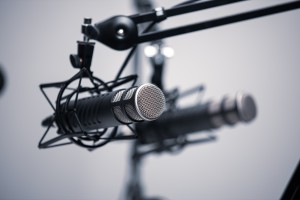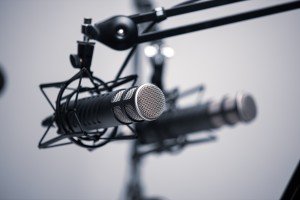Pieces of audio gear can be a bit like people: each has their own personality. It’s the same for the audio device called the microphone – the first link in your home voice-over studio’s “audio chain”.
Some mics are warm and pleasant. Others are bright and just a tad brittle. Others are really flat and neutral. In this post, we’ll look at microphones and how to select one. In a subsequent post regarding your studio’s audio chain, we’ll check out mic preamps, digital audio workstations, monitors and headphones, and the final products that you actually send to your client: file formats.
Now, the key to purchasing a microphone for your personal studio is to match the characteristics of your voice to the characteristics of a mic. Let’s look at how to do that!
Shootout at the Old Mic Corral

If you’re just starting out, your budget is probably fairly limited. You probably won’t be laying down ten grand for a vintage Neumann U47 microphone, one of the most iconic mics in recording history. So, just how do you select the mic that’s right for your voice and your budget?
Professional recording studios will sometimes conduct a “mic shootout” to determine which mic will sound best on a lead vocalist. Usually, condenser mics are used for recording vocals, but not always. Some singers and engineers prefer dynamic mics. The audio engineer will line up four or five microphones and the singer will sing into each one of them to see which mic fits the singer’s voice best. What constitutes best? In the case of a singer, say a male baritone with a rich, round sound, and instrumentation that sounds very much like the singer’s voice, (deep, rich and round) the engineer might select a mic that won’t accentuate the bottom end of the singer’s voice and will slightly accentuate the mid to upper range, so the voice cuts through the instrumentation.
You can do your own mic shootout, either in real life or virtually. As of this writing, many areas of the U.S. are under lockdown related to the COVID-19 pandemic, so going to a shop might not be possible. That said, let’s talk normal life, when we can go shopping. You can go to a professional audio equipment retailer and ask them to set up your own mic shootout. Take along a friend or fellow voice talent to be a second set of ears for you. Tell the audio pro what the mic will be used for and your price range. If the salesperson is astute, he or she will have listened to your voice and already decided which mics might work best with your voice. Most likely, they will be condenser mics. Make sure each mic you test runs through the same mic preamplifier into the recording device, with no added audio processing such as compression or equalization. For playback, make sure the same amplifier and speakers are used. That way you’ll hear the difference in just the mics and not other parts of the audio chain. Make sure you address each mic from the same distance at the same angle and read the same material. Read into each mic soft, medium, and loud. Go through the full range of your voice.
After you finish recording, do a blind playback test. Have the audio pro play the recording done on each mic without telling you which mic it is, so you can make an unbiased selection. Listen for the one that reproduces your voice most naturally. Remember, your voice might be used all by itself, or it could have music and sound effects mixed under it. If the person assisting you is nice enough, they might lay some music under your voice to see how it sounds. Ask the salesperson and your friend, if you brought someone along, for their opinions, then decide. Of course, you should buy the microphone from the pro audio shop that just went to all the trouble to assist you in your choice. Paying a bit more for your mic is a good investment in someone who’ll be there when and if something goes wrong with it. And you’ll also have a resource, a knowledgeable person you can contact for information and advice about the other equipment you’ll need for your studio.
When in Doubt, Google About
Okay, so what can you do if you don’t have a pro audio shop within reasonable driving distance? Well, you can do your own virtual mic shootout. Search online for microphones in your price range. After you make a list, do a search for reviews of each mic. You’ll find reviews of mics and other audio products on many of the big online pro audio retailer sites. You’ll also find reviews in pro audio magazines, both online and on good old fashioned paper, e.g., Mix, Sound on Sound, Tape Op, Electronic Musician, and Recording.
For each microphone review, note the key words used to describe the mic, e.g., “a bit tubby,” “brittle high end,” “large proximity effect,” “boxy midrange,” etc. Using your notes and the characteristics of your voice, find mics that accurately capture your voice, ones that would help your voice sound most natural and clear. Decide which one might be best and place your order. Make sure you order from a reputable online retailer that does full refunds, not credit for another item. With that in mind, you could actually do your own real life mini mic shootout at home. If you have enough room on your credit card, buy your top two choices from different retailers, compare them, choose the best one, then return the other one for a refund.
More Info From Mic Mavens
There are places online where you can hear audio samples of microphones both vintage and modern. Check out coutant.org/contents. It’s mic geek heaven! Long time VO pro Don Capone at Nurple Voice Over Studio has a great list of voice-over mics, including his review of each one, ranging in price from about $150.00 to that $10k Neumann U47 mentioned above. You can find that here.
And, of course, the folks here at SAV have put together a starter studio package featuring a very well-respected audio brand: Focusrite. The Home Studio Equipment Package includes a Focusrite CM25 condenser microphone, Focusrite Scarlett Solo mic preamp/USB audio interface, Focusrite Scarlett headphones, deluxe adjustable mic stand, high quality pop filter, and cables to connect everything. All for a very reasonable price to SAV members.
So those are a few paths to try in your quest for the mic that’s right for you. A little research can go a long way to getting your voice-over studio and career off to a great start. The next installment of this short audio chain series will focus on mic preamps and audio interfaces, which, nowadays, very often come in one little box. Cool.
Read part two of this series here!





